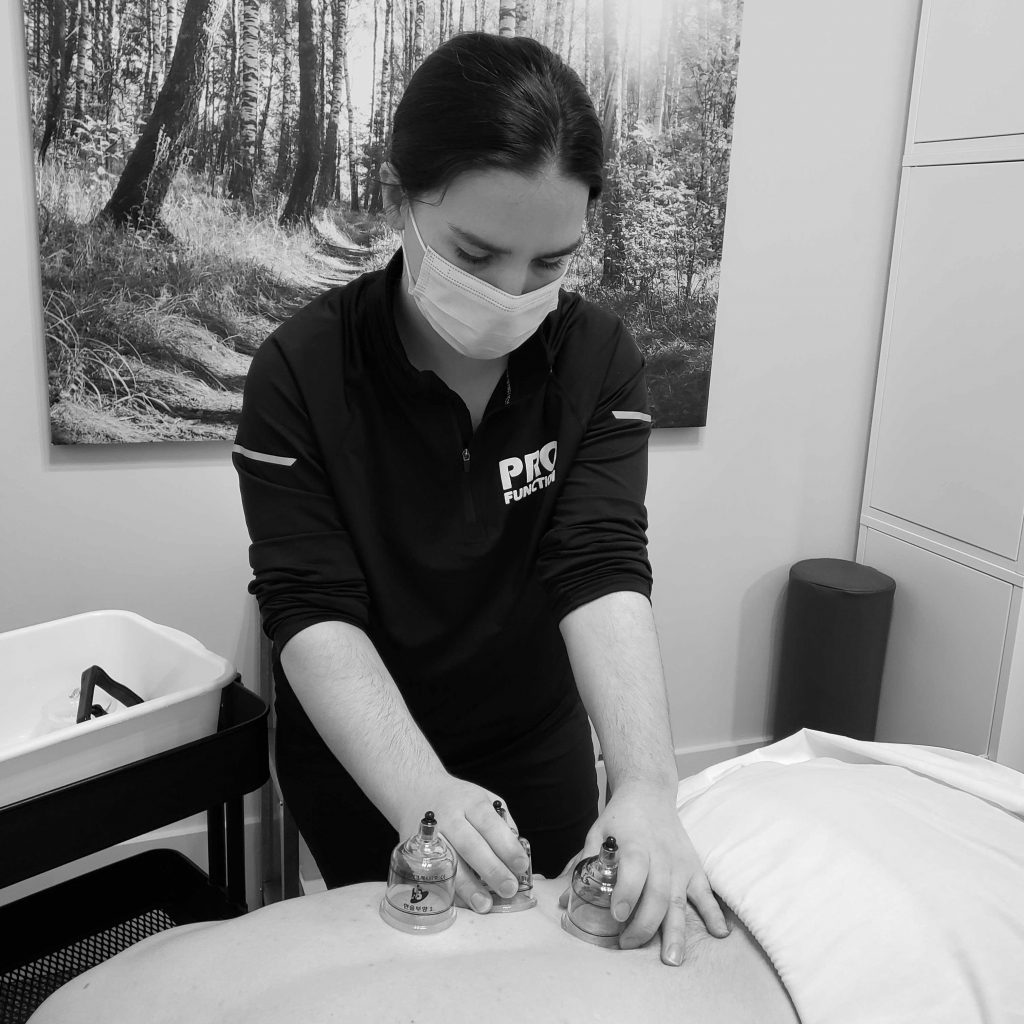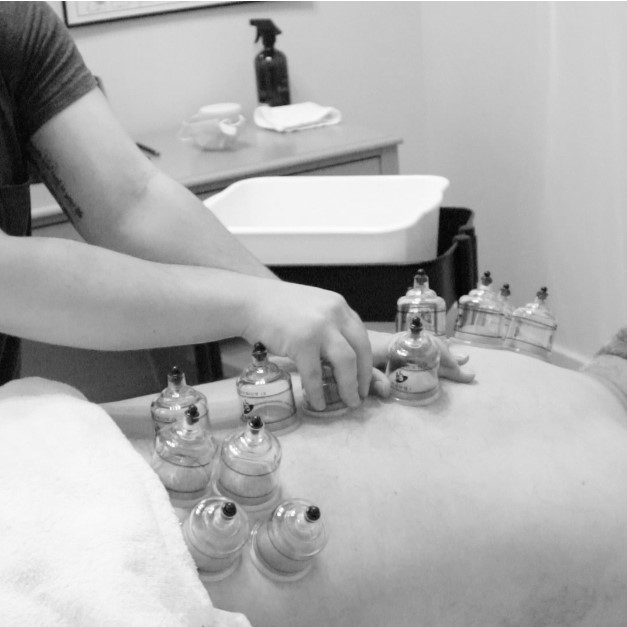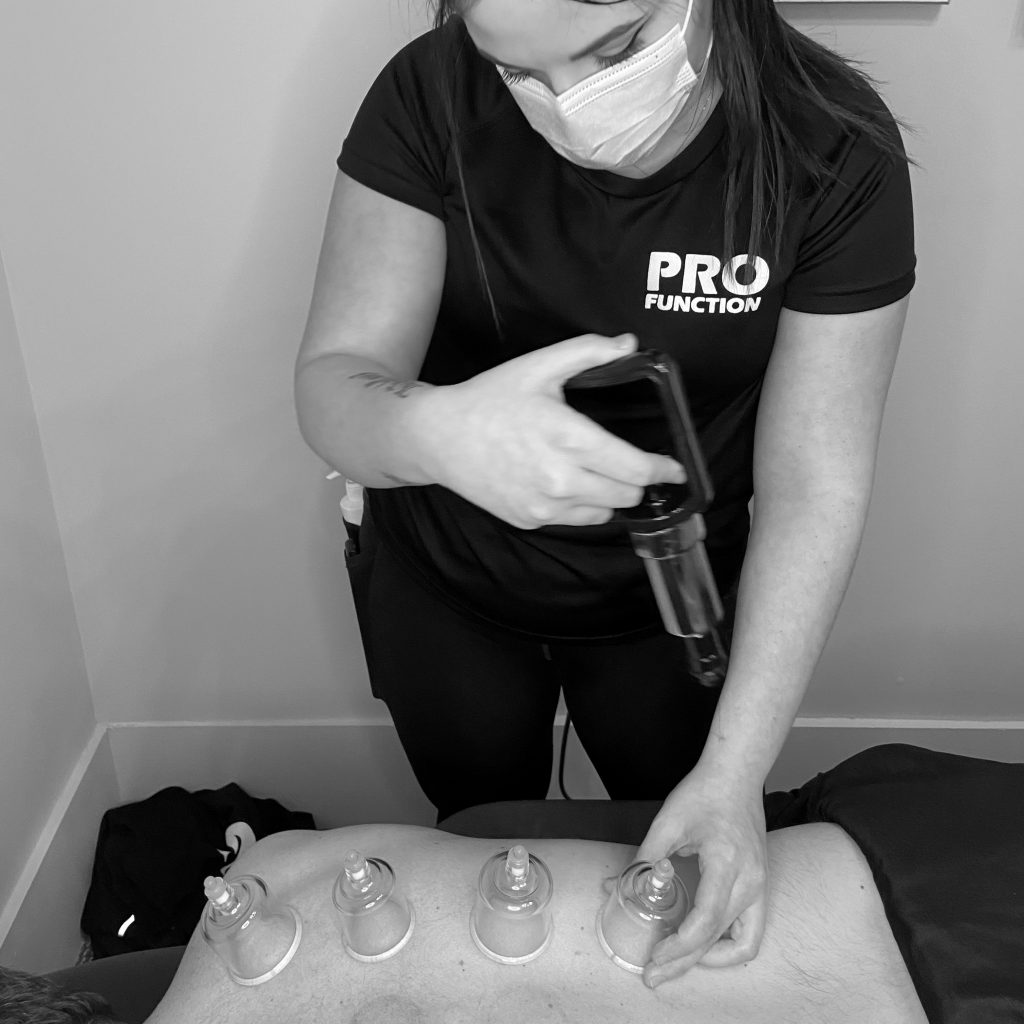Cupping Therapy
Cupping Therapy at Pro Function
What is Cupping Therapy?
Cupping Therapy is a therapy that uses cups placed onto a person’s skin with suction that decompresses muscles and connective tissue. This helps blood flow to the compromised area, enhances local circulation and helps to increase the body’s own healing processes — almost like a backward deep tissue massage. Sometimes the tissue just needs some space.
Every body is different, so when treating using cups each session is unique to each patient. When suction is added, less or more can be used, communication between therapist and patient is continuous. Depending on how the tissue feels, cups can be added and left stationary.
There are many different techniques used with the cups, as another option is applying lotion to the skin and gliding the cups over the tissue involved. This allows the therapist and patient to feel and see where there may be some fascial restrictions.
What are the benefits of Cupping Therapy?
- Release fascial restrictions
- Helps with treating painful trigger points.
- Improve local circulation, blood and lymph circulation.
- Relieve pain by giving tissue space to the tissue
- Promote mobility and range of motion.
What Does Cupping Therapy Actually Do?
Cupping Therapy encourages circulation
One of the most impressive benefits of cupping therapy is the way it improves and stimulates overall circulation. The cups dilate the blood vessels which encourages the fluids of the body to move better to their proper destinations. Improving this process increases the output of blood, which in turn increases the venous return. Veins are more superficial so they are affected first by the cupping therapy, because they are so close to the skin, not a lot of suction is need to
cause an affect. Soft suction and movement toward the trunk of the body helps the valves in the veins to perform their functions. Cupping therapy can also be beneficial for high and low blood pressure in some people. Starting with soft suction is always important as the body need to time to get use to this type of therapy, with low blood pressure after treatment people may feel a little dizzy after cupping due to the sudden “rush” in their circulation, so as with other therapies make sure you take your time getting up after treatment.
Cupping Therapy alleviates adhesions
Cupping therapy addresses adhesions, and they are defined as any two anatomical surfaces that become stuck or start growing together due to injury or inflammation. This can happen to muscles, connective tissue, visceral organs and even across body systems. During treatment when the cup is applied to the skin and they can be left in areas to just sit and affect tissue that way but the other technique is to move the cups across the skin. With movement of the cups
you can feel the adhesions and they will stick in those areas.
Cupping Therapy helps clear congestion and stagnation
Cupping therapy helps clear stagnation which is the state of not flowing or moving. Cups help clear this which helps improve the health of the skin, muscles, bones, joints and organs. An example is, reduced or limited movement of a joint, such as frozen shoulder. Stagnation of inflammation within the joint, applying cups gives movement to the fluids and tissue which is what is needed to reduce the stagnation as well as the congestion in this specific area. The
inflammation causes heat in the area which dehydrates the surrounding muscles, leading to lack of flexibility and leads to limited range of motion.
Cupping Therapy can lift, rehydrate and manipulate fascia
Fascia is a band or sheet of connective tissue, primarily collagen, beneath the skin that attaches, stabilizes, encloses, and separates muscles and other internal organs. When this connective tissue forms restrictions, the process of getting the tissue to release using the cups as well as massage the cupping forces hydration to pass through these fluid-rich structures, which improve then movement allowed by the fascia that may have been otherwise dehydrated
and stuck. Using the cups creates negative pressure which allows for a lifting and stretching mechanism to happen, creating space in the tissue.
Cupping Therapy can cause microtrauma in tissues
Causing trauma sounds like the wrong way to do treatment, but with cupping therapy causing beneficial inflammation helps to encourage the body’s own process of regeneration. So, this is where the proper suction comes into play, this idea of needing to feel pain or extreme soreness isn’t helping in the treatment of soft tissue. Walking out of a treatment with those very noticeable “bruises”, saying that must have been a great session, isn’t true. An increase to a stronger suction is something to work up to, let the tissue get use to this new treatment.
Cupping Therapy encourages neovascularization
The process by which blood vessels form from already existing healthy vessels, bringing a fresh supply of nutrients and oxygen to previously deficient tissues. In areas of injury or damaged tissue for example physical exertion leading to a muscle tearing, cupping can stimulate this response in regional tissues, which in turn can speed recovery. If there is a severely injured tissue cupping should not be used, same as when using other treatments such as massage therapy, more damage can be caused, let the tissue heal enough before treatment is applied.
Here's a Quick List of Conditions Treated with Cupping Therapy
– Post Surgical Scars
– Lymphodema
– Sports & Training Recovery
– Myofascial tension
– Trigger points
Your First Appointment at Pro Function
Before your first treatment your Massage Therapist will propose a personalized treatment plan based on an initial assessment and health history. This assessment can consist of various tests to determine the possible cause of your pain, discomfort, or dysfunction and whether massage therapy is indicated for you. After your initial assessment is complete your Massage Therapist will proceed with your first treatment. At all times the Massage Therapist will work within your level of pain tolerance and will maintain open communication with you. The treatment can be stopped or modified at any time should the treatment cause discomfort.




